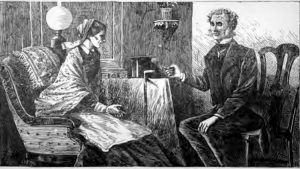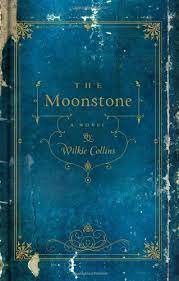
If you think the first English detective novel, written in Dickens’s day, would be too dated to bother reading, think again. The Moonstone remains to this day a cracking good yarn, offering engaging and colourful characters, a dark mystery tinged with the exotic and laden with social critique, plenty of suspense and an unexpected ending. Right to the final pages, the question remains: who dun it?
A precursor
Edgar Allen Poe had several pivotal crime mystery short stories out by the time The Moonstone appeared in 1868, but being a full-length novel, Wilkie Collins landed the title grandfather of the detective novel. The Moonstone set many of the ground rules for the popular genre it spawned. These include an English country house robbery; a ‘locked-room’ puzzle; a cast of eccentric characters, each potentially with a motive; bungling rural police; the entrance of a celebrated, skilled detective; numerous red herrings and false leads; the reader being granted all the clues to solve the crime at the same time as the detective; a recreation of the crime; a surprise plot twist as the novel’s dénouement.
Plot
In her Yorkshire country home, Rachel Verinder is getting ready for her 18th birthday celebration. Lady Verinder plays host, various visitors will arrive and several house servants are present. Rachel’s dashing cousin, Franklin Blake, brings her a gift of a flawed yet beautiful yellow diamond, the moonstone, from London. This has been sent by her bitter old uncle, a military man who served in the British Raj. Rachel has no idea that the stone brings great danger with it, for this diamond has been stolen from a Hindu temple in India, and is imbued with a curse. When the moonstone goes missing during the night, stolen from Rachel’s bedroom cabinet, the ensuing investigation gradually brings to light the sinister history of the diamond plus the passions and machinations of those close to Rachel.
Sinister mystery of the East
Lurking Hindu gentlemen outside the walls of the Verinder mansion appear at some point, eventually linked by the characters to the moonstone’s original theft. Thus the book offers a dark portrayal of Indian colonialism. Author Robert McCrum comments:
“The original crime in The Moonstone, the theft of the Tippoo diamond after the fall of Seringapatam, is probably Collins’s masterstroke. It connects every detail of the plot to the great imperial drama of India, the society over which Queen Victoria would eventually declare herself ‘Empress’. From the outset, the Indian factor imbues the tale with the sinister mystery of the East.
1

A novel of letters
Presented through diary entries and letters from all who were in the house during the robbery, these first-hand accounts are gathered together by Franklin Blake. In this way, The Moonstone fits the tradition of the English epistolary novel. By offering eleven different narrators, it varies dramatically in tone and perspective, and with this technique, which we now call parallel narratives to build a picture of the crime based on multiple points of view all resting on the authors’ memories of events. This allows the narrative to explore ideas about the unreliable narrator, the fallibility of memory, and subjective bias —ideas that often inform contemporary fiction.
Franklin Blake sets the terms for the letters:
‘We have certain events to relate,’ Mr Franklin proceeded; ‘and we have certain persons concerned in those events who are capable of relating them. Starting from these plain facts, the idea is that we should all write the story of the Moonstone in turn—as far as our own personal experience extends, and no farther.’ 2
Ultimately, what he suggests is only direct experience qualifies a person to tell the story. The narrators are limited to their own memories only.

Characters
The characters are wonderfully eccentric, among them the butler Gabriel Betteredge, who turns to the pages of Robinson Crusoe as a solution to all life’s challenges; the meddlesome God-bothering Miss Clark; the disfigured, impassioned and thwarted servant girl Lucy and the opium addict, Ezra Jennings.
Several of the characters are servants, and portrayed sympathetically, which was not common for a Victorian novel. In fact, a critique of the inequalities of his society runs throughout Collins’ work.
“Wilkie Collins actually makes a profound political commentary through the narration of Gabriel Betteredge, who criticizes the tendency of the wealthy to create messy, pointless hobbies to fill the void left by their lack of productive labor.” 3

Critical responses
T. S. Eliot proclaimed the book “the first, the longest, and the best of modern English detective novels in a genre invented by Collins and not by Poe,”4
Crime writer Dorothy L. Sayers said: ‘Probably the very finest detective story ever written.
‘Robert McCrum: “The upshot is his masterpiece, a brilliant marriage of the sensational and the realistic.”5
Where does memory loss fit?
Spoiler territory ahead: The Moonstone does not involve a case of classical amnesia caused by an injury or trauma, instead there is a character whose memory is wiped clean due to the imbibing of opium. This factor is central to the plot, and comes as a great surprise, although if one backtracks all the clues are on the page.
Apparently, Collins drew inspiration from his own experience for this element.
The Moonstone entry in Penguin/Random House states that:
Sadly, the opium-induced experiences of Ezra Jennings describe Collins’s own illness. As he was writing The Moonstone, the painful gout from which Collins had long suffered began to attack with increasing frequency and severity. No effective treatment was known at the time. He could find relief only in increasing doses of laudanum, an opium derivative. Collins soon required doses that would have killed anyone not habituated to the drug, first to get through the night, then increasingly in the daytime as well. Indeed he claimed that after he first outlined the book’s plot, opium wiped it almost entirely from his memory. Only his careful notes allowed him to proceed with the composition.
I loved this book, and so far rate it as one of my favourite memory loss stories.
Footnotes
- Robert McCrum, The novel 1832–1880, May 2014, https://www.bl.uk/romantics-and-victorians/articles/an-introduction-to-the-moonstone
- (1.1.1.8)
- Shmoop: https://www.shmoop.com/study-guides/literature/the-moonstone/themes/society-and-class
- David, Deirdre The Cambridge Companion to the Victorian Novel p179. Cambridge University Press, 2001.
- https://www.shmoop.com/study-guides/literature/the-moonstone/quotes/memory-and-the-past
- https://www.penguinrandomhouse.com/books/260151/the-moonstone-by…/readers-guide/